UNIT 4 Scientists who changed the world 单元提能强化练--2025译林版高中英语必修第三册同步练习题(含答案与解析)
文档属性
| 名称 | UNIT 4 Scientists who changed the world 单元提能强化练--2025译林版高中英语必修第三册同步练习题(含答案与解析) | 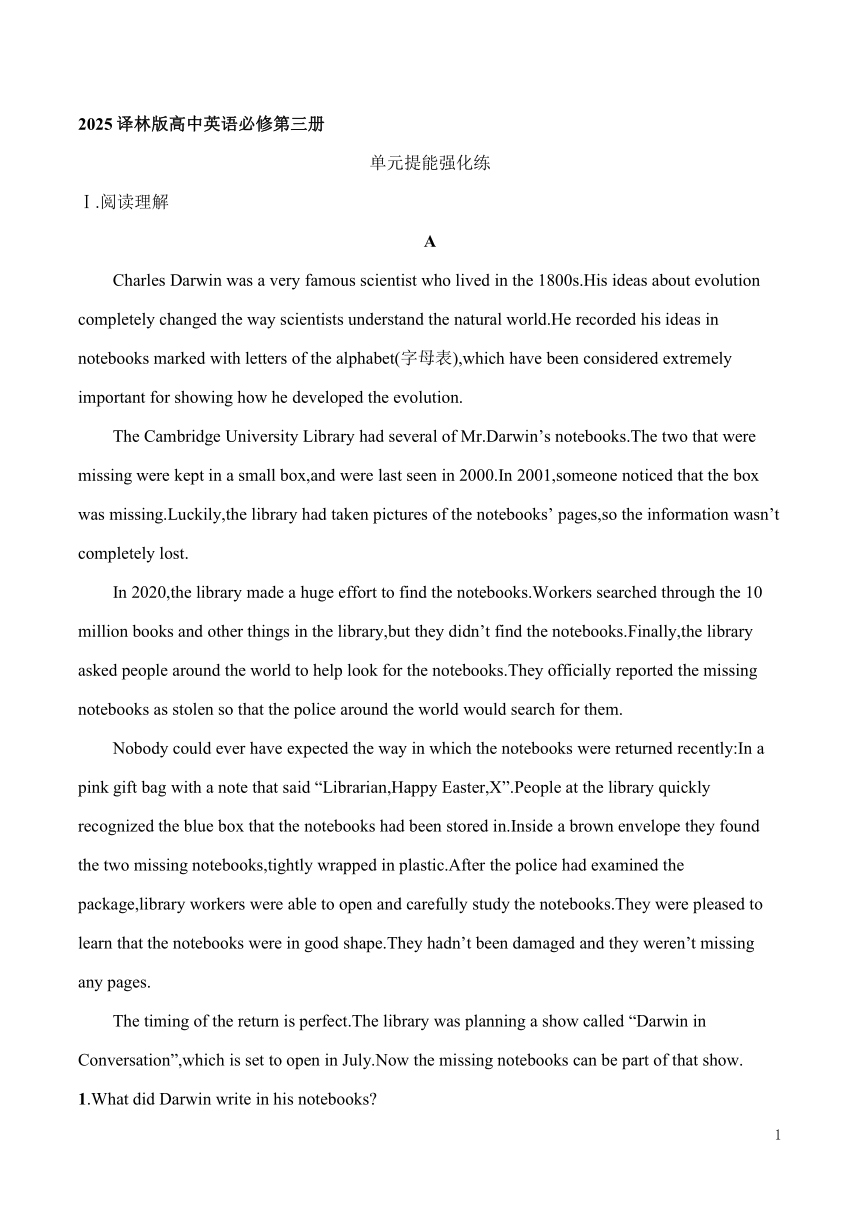 | |
| 格式 | docx | ||
| 文件大小 | 31.1KB | ||
| 资源类型 | 试卷 | ||
| 版本资源 | 牛津译林版(2019) | ||
| 科目 | 英语 | ||
| 更新时间 | 2025-06-16 12:26:33 | ||
图片预览

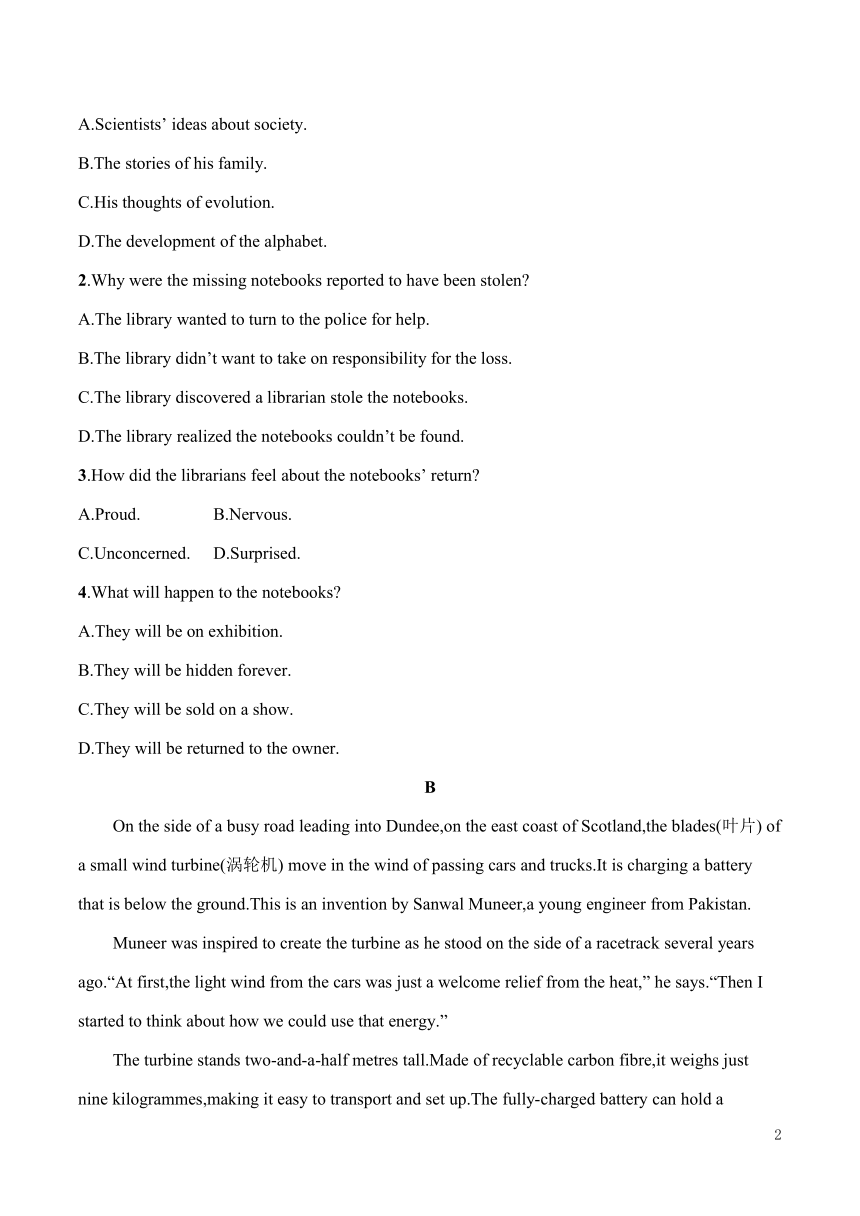
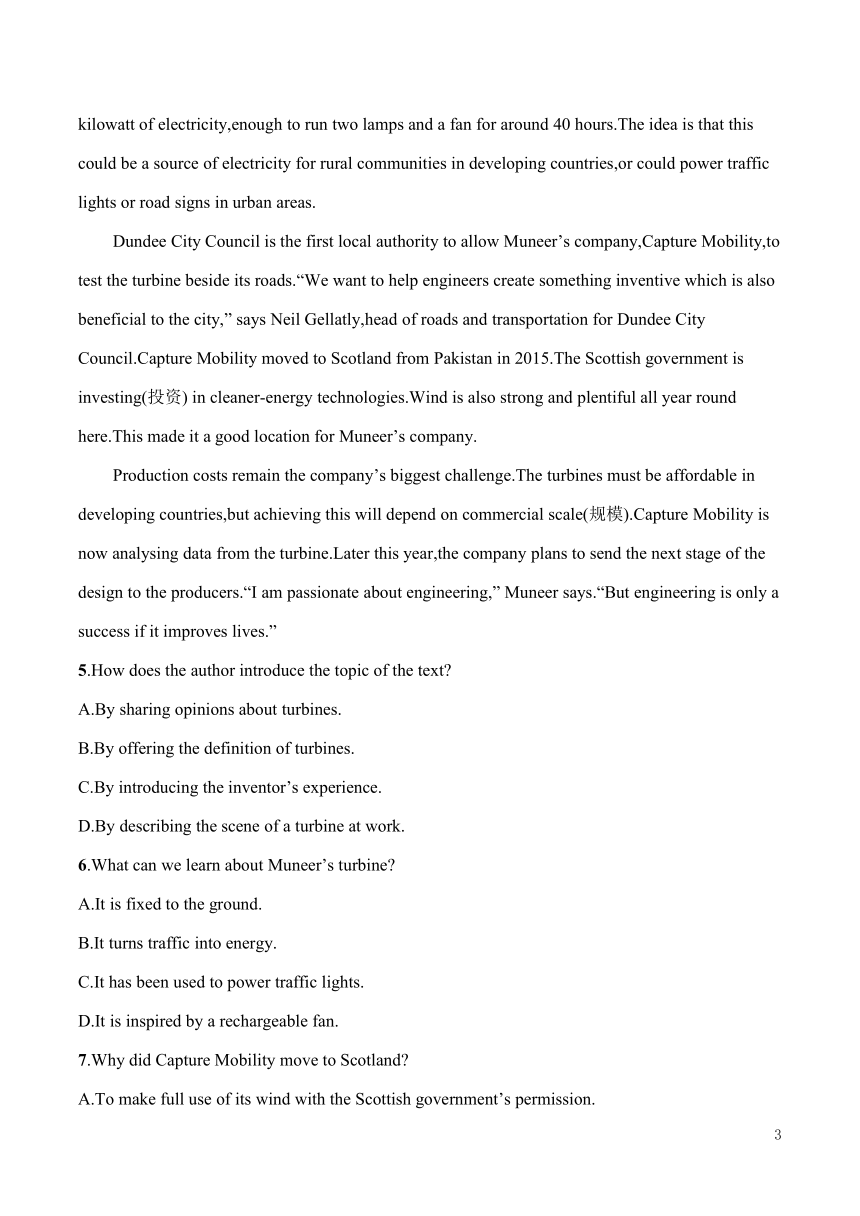
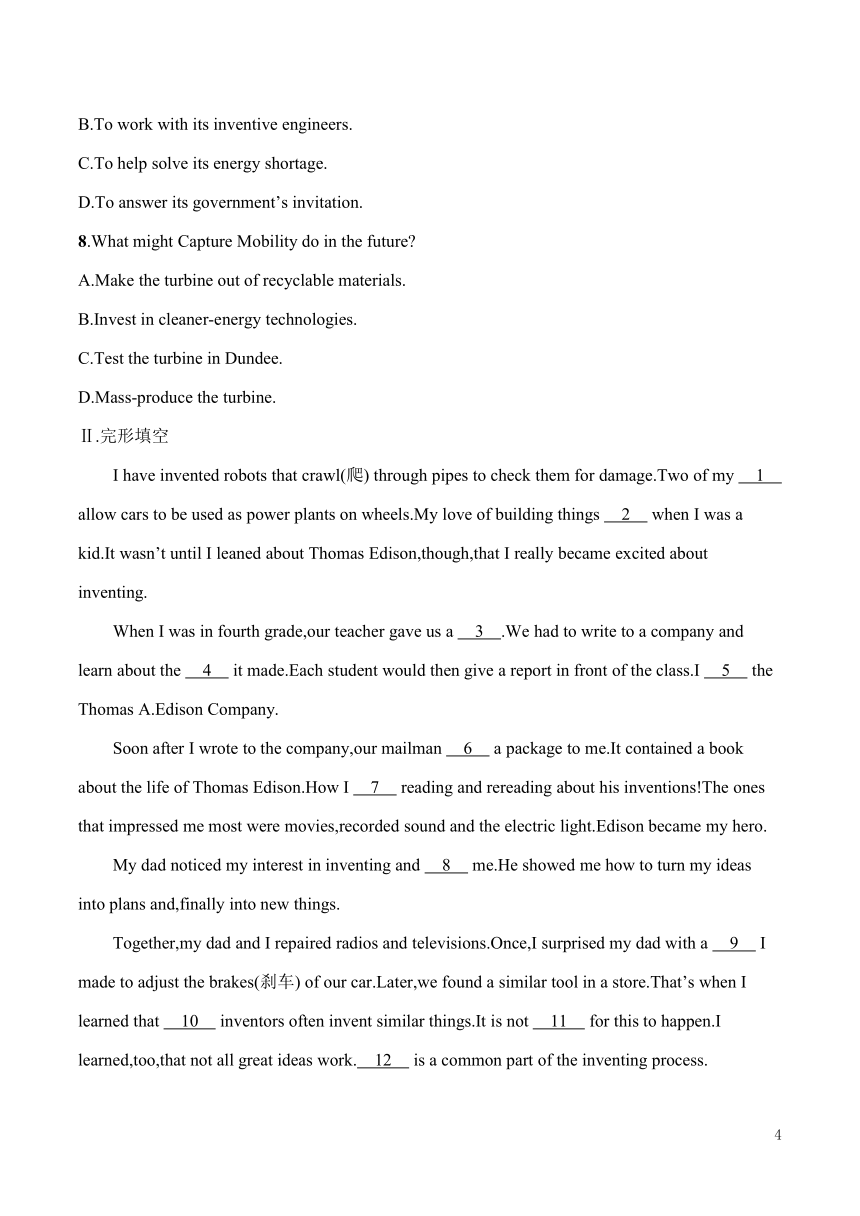
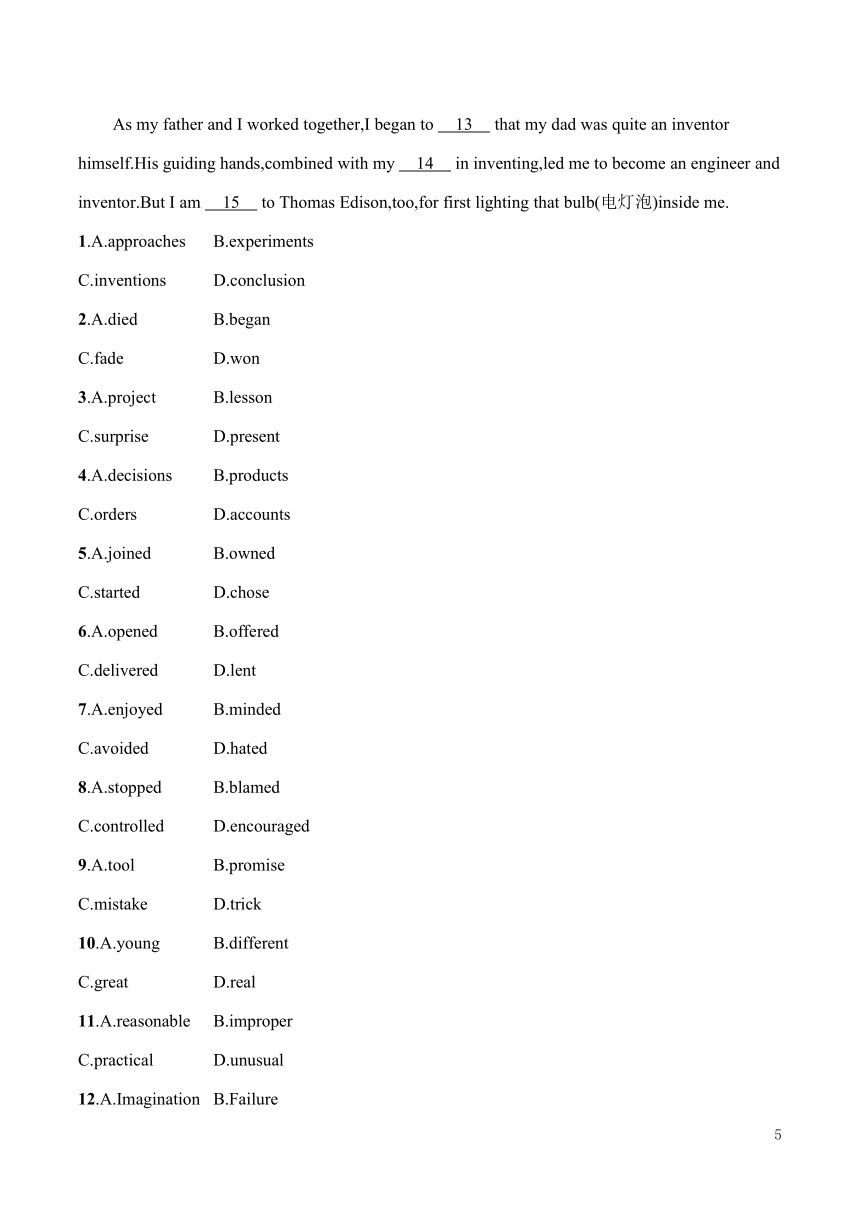
文档简介
2025译林版高中英语必修第三册
单元提能强化练
Ⅰ.阅读理解
A
Charles Darwin was a very famous scientist who lived in the 1800s.His ideas about evolution completely changed the way scientists understand the natural world.He recorded his ideas in notebooks marked with letters of the alphabet(字母表),which have been considered extremely important for showing how he developed the evolution.
The Cambridge University Library had several of Mr.Darwin’s notebooks.The two that were missing were kept in a small box,and were last seen in 2000.In 2001,someone noticed that the box was missing.Luckily,the library had taken pictures of the notebooks’ pages,so the information wasn’t completely lost.
In 2020,the library made a huge effort to find the notebooks.Workers searched through the 10 million books and other things in the library,but they didn’t find the notebooks.Finally,the library asked people around the world to help look for the notebooks.They officially reported the missing notebooks as stolen so that the police around the world would search for them.
Nobody could ever have expected the way in which the notebooks were returned recently:In a pink gift bag with a note that said “Librarian,Happy Easter,X”.People at the library quickly recognized the blue box that the notebooks had been stored in.Inside a brown envelope they found the two missing notebooks,tightly wrapped in plastic.After the police had examined the package,library workers were able to open and carefully study the notebooks.They were pleased to learn that the notebooks were in good shape.They hadn’t been damaged and they weren’t missing any pages.
The timing of the return is perfect.The library was planning a show called “Darwin in Conversation”,which is set to open in July.Now the missing notebooks can be part of that show.
1.What did Darwin write in his notebooks
A.Scientists’ ideas about society.
B.The stories of his family.
C.His thoughts of evolution.
D.The development of the alphabet.
2.Why were the missing notebooks reported to have been stolen
A.The library wanted to turn to the police for help.
B.The library didn’t want to take on responsibility for the loss.
C.The library discovered a librarian stole the notebooks.
D.The library realized the notebooks couldn’t be found.
3.How did the librarians feel about the notebooks’ return
A.Proud. B.Nervous.
C.Unconcerned. D.Surprised.
4.What will happen to the notebooks
A.They will be on exhibition.
B.They will be hidden forever.
C.They will be sold on a show.
D.They will be returned to the owner.
B
On the side of a busy road leading into Dundee,on the east coast of Scotland,the blades(叶片) of a small wind turbine(涡轮机) move in the wind of passing cars and trucks.It is charging a battery that is below the ground.This is an invention by Sanwal Muneer,a young engineer from Pakistan.
Muneer was inspired to create the turbine as he stood on the side of a racetrack several years ago.“At first,the light wind from the cars was just a welcome relief from the heat,” he says.“Then I started to think about how we could use that energy.”
The turbine stands two-and-a-half metres tall.Made of recyclable carbon fibre,it weighs just nine kilogrammes,making it easy to transport and set up.The fully-charged battery can hold a kilowatt of electricity,enough to run two lamps and a fan for around 40 hours.The idea is that this could be a source of electricity for rural communities in developing countries,or could power traffic lights or road signs in urban areas.
Dundee City Council is the first local authority to allow Muneer’s company,Capture Mobility,to test the turbine beside its roads.“We want to help engineers create something inventive which is also beneficial to the city,” says Neil Gellatly,head of roads and transportation for Dundee City Council.Capture Mobility moved to Scotland from Pakistan in 2015.The Scottish government is investing(投资) in cleaner-energy technologies.Wind is also strong and plentiful all year round here.This made it a good location for Muneer’s company.
Production costs remain the company’s biggest challenge.The turbines must be affordable in developing countries,but achieving this will depend on commercial scale(规模).Capture Mobility is now analysing data from the turbine.Later this year,the company plans to send the next stage of the design to the producers.“I am passionate about engineering,” Muneer says.“But engineering is only a success if it improves lives.”
5.How does the author introduce the topic of the text
A.By sharing opinions about turbines.
B.By offering the definition of turbines.
C.By introducing the inventor’s experience.
D.By describing the scene of a turbine at work.
6.What can we learn about Muneer’s turbine
A.It is fixed to the ground.
B.It turns traffic into energy.
C.It has been used to power traffic lights.
D.It is inspired by a rechargeable fan.
7.Why did Capture Mobility move to Scotland
A.To make full use of its wind with the Scottish government’s permission.
B.To work with its inventive engineers.
C.To help solve its energy shortage.
D.To answer its government’s invitation.
8.What might Capture Mobility do in the future
A.Make the turbine out of recyclable materials.
B.Invest in cleaner-energy technologies.
C.Test the turbine in Dundee.
D.Mass-produce the turbine.
Ⅱ.完形填空
I have invented robots that crawl(爬) through pipes to check them for damage.Two of my 1 allow cars to be used as power plants on wheels.My love of building things 2 when I was a kid.It wasn’t until I leaned about Thomas Edison,though,that I really became excited about inventing.
When I was in fourth grade,our teacher gave us a 3 .We had to write to a company and learn about the 4 it made.Each student would then give a report in front of the class.I 5 the Thomas A.Edison Company.
Soon after I wrote to the company,our mailman 6 a package to me.It contained a book about the life of Thomas Edison.How I 7 reading and rereading about his inventions!The ones that impressed me most were movies,recorded sound and the electric light.Edison became my hero.
My dad noticed my interest in inventing and 8 me.He showed me how to turn my ideas into plans and,finally into new things.
Together,my dad and I repaired radios and televisions.Once,I surprised my dad with a 9 I made to adjust the brakes(刹车) of our car.Later,we found a similar tool in a store.That’s when I learned that 10 inventors often invent similar things.It is not 11 for this to happen.I learned,too,that not all great ideas work. 12 is a common part of the inventing process.
As my father and I worked together,I began to 13 that my dad was quite an inventor himself.His guiding hands,combined with my 14 in inventing,led me to become an engineer and inventor.But I am 15 to Thomas Edison,too,for first lighting that bulb(电灯泡)inside me.
1.A.approaches B.experiments
C.inventions D.conclusion
2.A.died B.began
C.fade D.won
3.A.project B.lesson
C.surprise D.present
4.A.decisions B.products
C.orders D.accounts
5.A.joined B.owned
C.started D.chose
6.A.opened B.offered
C.delivered D.lent
7.A.enjoyed B.minded
C.avoided D.hated
8.A.stopped B.blamed
C.controlled D.encouraged
9.A.tool B.promise
C.mistake D.trick
10.A.young B.different
C.great D.real
11.A.reasonable B.improper
C.practical D.unusual
12.A.Imagination B.Failure
C.Happiness D.Wealth
13.A.hope B.suggest
C.realize D.consider
14.A.honor B.difficulty
C.experience D.interest
15.A.grateful B.polite
C.related D.equal
Ⅲ.读后续写
阅读下面材料,根据其内容和所给段落开头语续写两段,使之构成一篇完整的短文。
(2024新课标Ⅱ卷)
I met Gunter on a cold,wet and unforgettable evening in September.I had planned to fly to Vienna and take a bus to Prague for a conference.Due to a big storm,my flight had been delayed by an hour and a half.I touched down in Vienna just 30 minutes before the departure of the last bus to Prague.The moment I got off the plane,I ran like crazy through the airport building and jumped into the first taxi on the rank without a second thought.
That was when I met Gunter.I told him where I was going,but he said he hadn’t heard of the bus station.I thought my pronunciation was the problem,so I explained again more slowly,but he still looked confused.When I was about to give up,Gunter fished out his little phone and rang up a friend.After a heated discussion that lasted for what seemed like a century,Gunter put his phone down and started the car.
Finally,with just two minutes to spare we rolled into the bus station.Thankfully,there was a long queue(队列) still waiting to board the bus.Gunter parked the taxi behind the bus,turned around,and looked at me with a big smile on his face.“We made it,” he said.
Just then I realised that I had zero cash in my wallet.I flashed him an apologetic smile as I pulled out my Portuguese bankcard.He tried it several times,but the card machine just did not play along.A feeling of helplessness washed over me as I saw the bus queue thinning out.
At this moment,Gunter pointed towards the waiting hall of the bus station.There,at the entrance,was a cash machine.I jumped out of the car,made a mad run for the machine,and popped my card in,only to read the message:“Out of order.Sorry.”
注意:
1.续写词数应为150左右;
2.请按如下格式在相应位置作答。
I ran back to Gunter and told him the bad news.
Four days later,when I was back in Vienna,I called Gunter as promised.
UNIT 4
单元提能强化练
Ⅰ.【语篇导读】本文是一篇记叙文。文章讲述的是19世纪著名科学家达尔文的两本标有关于进化论观点的笔记本丢失以及回归的故事。
1.C 细节理解题。根据第一段中“He recorded his ideas in notebooks marked with letters of the alphabet,which have been considered extremely important for showing how he developed the evolution.”可知,该笔记本中标注的是他关于进化论的思想。
2.A 细节理解题。根据第三段中“They officially reported the missing notebooks as stolen so that the police around the world would search for them.”可知,将遗失的笔记本报告为被盗可以得到全世界警察的帮助。
3.D 推理判断题。根据倒数第二段中“Nobody could ever have expected the way in which the notebooks were returned recently”可知,对于笔记本的回归,图书管理员感到很惊讶。
4.A 推理判断题。根据最后一段中“Now the missing notebooks can be part of that show.”可知,两个笔记本也有可能会成为接下来展览的一部分。故选A项。
【语篇导读】本文是一篇说明文。文章主要介绍了一个新的发明,可以利用道路上汽车等交通工具驶过时带来的风能,将其通过风力涡轮机转变成电能,从而成为社区的电力来源。
5.D 推理判断题。根据第一段内容可推断,作者通过描述了一个涡轮机在工作的场景引出主题。
6.B 细节理解题。根据第二段内容可知,Muneer所设计的涡轮机是将交通工具产生的风能变成电能。
7.A 推理判断题。根据第四段中的“Capture Mobility moved to Scotland from Pakistan in 2015.The Scottish government is investing in cleaner-energy technologies ...Muneer’s company.”可推断,搬到苏格兰的原因是在苏格兰政府的支持下充分利用当地风能。
8.C 推理判断题。根据第四段中的“Dundee City Council is the first local authority...roads.”以及最后一段中的“Capture Mobility is now analysing data from the turbine.”可推断,接下来该公司将在Dundee测试涡轮机。
Ⅱ.【语篇导读】本文是一篇记叙文。作者从小对发明感兴趣,通过做学习课题任务,他更加热爱发明和崇拜爱迪生。在爸爸的影响和帮助下,他最终成了一名发明家。
1.C 根据全文第一句中的“I have invented robots”及下文内容可以看出inventions在此处符合语境。
2.B 根据本空后的“when I was a kid”可知,此处指从孩子时“开始的”。
3.A 根据下文可知,这是学校里老师分配给学生做的课题。
4.B 根据下文作者收到的包裹里有“movies,recorded sound and the electric light”可知,此处指了解公司产品。
5.D 根据本段内容可知,作者要了解公司产品,然后在班级里做报告,因此作者“选择”了Thomas A.Edison公司。
6.C 由mailman可知,delivered符合语境,指“邮递员派送包裹”。
7.A 根据上文可知,作者非常崇拜爱迪生,因此喜欢阅读有关爱迪生发明的书。
8.D 根据下文中的“He showed me how to turn my ideas into plans and,finally into new things.”可推测爸爸鼓励作者继续发明。
9.A 根据下文“Later,we found a similar tool in a store.”可知我们在商店发现了类似的工具,因此此处指“工具”。
10.B 结合上文情境,我们在商店发现了类似于作者的发明的工具,那时作者才知道,不同的发明家经常发明类似的东西。
11.D 作者在学习发明的过程中了解到,不同的发明家发明类似的东西,这种情况很常见。
12.B 根据上一句“I learned,too,that not all great ideas work.”可知不是所有的很棒的想法都能实现,因此failure符合语境。
13.C 当父亲和我一起工作时,我开始意识到我父亲自己也是一个发明家。
14.D 有了他的指导,加上我对发明的兴趣,我成了一名工程师和发明家。根据文章开头的讲述可知,作者从小就对发明感兴趣。
15.A 结合全文内容可知,我十分崇拜爱迪生,可推测我也很感谢爱迪生,是他第一次点亮了我内心的那盏灯。
Ⅲ.I ran back to Gunter and told him the bad news.With a sense of urgency,I explained the situation with the cash machine being out of order and my inability to pay him for the ride.To my surprise,Gunter simply smiled and said,“Don’t worry about it.Just make sure to pay me back when you can.”He then handed me his phone number and told me to call him once I was settled in Prague.I thanked him,promising to repay him as soon as possible,and he nodded,understanding my dilemma.With a final wave,I rushed back to the bus,managing to board just as the doors were closing.As the bus pulled away,I looked out of the window and saw Gunter standing there,his reassuring smile still visible.
Four days later,when I was back in Vienna,I called Gunter as promised.I arranged to meet him at a nearby café to settle the fare and express my gratitude.When we met,I handed him the money and thanked him for his kindness and understanding.Over cups of coffee,we shared stories of our travels and experiences,finding common ground and a mutual appreciation for the unexpected kindness that can be found in strangers.It turned out that Gunter was a seasoned traveler himself and had a wealth of knowledge about the region.Our conversation flowed easily,and by the end of the meeting,we had become good friends,bonded by a chance encounter and a shared sense of adventure.
7
单元提能强化练
Ⅰ.阅读理解
A
Charles Darwin was a very famous scientist who lived in the 1800s.His ideas about evolution completely changed the way scientists understand the natural world.He recorded his ideas in notebooks marked with letters of the alphabet(字母表),which have been considered extremely important for showing how he developed the evolution.
The Cambridge University Library had several of Mr.Darwin’s notebooks.The two that were missing were kept in a small box,and were last seen in 2000.In 2001,someone noticed that the box was missing.Luckily,the library had taken pictures of the notebooks’ pages,so the information wasn’t completely lost.
In 2020,the library made a huge effort to find the notebooks.Workers searched through the 10 million books and other things in the library,but they didn’t find the notebooks.Finally,the library asked people around the world to help look for the notebooks.They officially reported the missing notebooks as stolen so that the police around the world would search for them.
Nobody could ever have expected the way in which the notebooks were returned recently:In a pink gift bag with a note that said “Librarian,Happy Easter,X”.People at the library quickly recognized the blue box that the notebooks had been stored in.Inside a brown envelope they found the two missing notebooks,tightly wrapped in plastic.After the police had examined the package,library workers were able to open and carefully study the notebooks.They were pleased to learn that the notebooks were in good shape.They hadn’t been damaged and they weren’t missing any pages.
The timing of the return is perfect.The library was planning a show called “Darwin in Conversation”,which is set to open in July.Now the missing notebooks can be part of that show.
1.What did Darwin write in his notebooks
A.Scientists’ ideas about society.
B.The stories of his family.
C.His thoughts of evolution.
D.The development of the alphabet.
2.Why were the missing notebooks reported to have been stolen
A.The library wanted to turn to the police for help.
B.The library didn’t want to take on responsibility for the loss.
C.The library discovered a librarian stole the notebooks.
D.The library realized the notebooks couldn’t be found.
3.How did the librarians feel about the notebooks’ return
A.Proud. B.Nervous.
C.Unconcerned. D.Surprised.
4.What will happen to the notebooks
A.They will be on exhibition.
B.They will be hidden forever.
C.They will be sold on a show.
D.They will be returned to the owner.
B
On the side of a busy road leading into Dundee,on the east coast of Scotland,the blades(叶片) of a small wind turbine(涡轮机) move in the wind of passing cars and trucks.It is charging a battery that is below the ground.This is an invention by Sanwal Muneer,a young engineer from Pakistan.
Muneer was inspired to create the turbine as he stood on the side of a racetrack several years ago.“At first,the light wind from the cars was just a welcome relief from the heat,” he says.“Then I started to think about how we could use that energy.”
The turbine stands two-and-a-half metres tall.Made of recyclable carbon fibre,it weighs just nine kilogrammes,making it easy to transport and set up.The fully-charged battery can hold a kilowatt of electricity,enough to run two lamps and a fan for around 40 hours.The idea is that this could be a source of electricity for rural communities in developing countries,or could power traffic lights or road signs in urban areas.
Dundee City Council is the first local authority to allow Muneer’s company,Capture Mobility,to test the turbine beside its roads.“We want to help engineers create something inventive which is also beneficial to the city,” says Neil Gellatly,head of roads and transportation for Dundee City Council.Capture Mobility moved to Scotland from Pakistan in 2015.The Scottish government is investing(投资) in cleaner-energy technologies.Wind is also strong and plentiful all year round here.This made it a good location for Muneer’s company.
Production costs remain the company’s biggest challenge.The turbines must be affordable in developing countries,but achieving this will depend on commercial scale(规模).Capture Mobility is now analysing data from the turbine.Later this year,the company plans to send the next stage of the design to the producers.“I am passionate about engineering,” Muneer says.“But engineering is only a success if it improves lives.”
5.How does the author introduce the topic of the text
A.By sharing opinions about turbines.
B.By offering the definition of turbines.
C.By introducing the inventor’s experience.
D.By describing the scene of a turbine at work.
6.What can we learn about Muneer’s turbine
A.It is fixed to the ground.
B.It turns traffic into energy.
C.It has been used to power traffic lights.
D.It is inspired by a rechargeable fan.
7.Why did Capture Mobility move to Scotland
A.To make full use of its wind with the Scottish government’s permission.
B.To work with its inventive engineers.
C.To help solve its energy shortage.
D.To answer its government’s invitation.
8.What might Capture Mobility do in the future
A.Make the turbine out of recyclable materials.
B.Invest in cleaner-energy technologies.
C.Test the turbine in Dundee.
D.Mass-produce the turbine.
Ⅱ.完形填空
I have invented robots that crawl(爬) through pipes to check them for damage.Two of my 1 allow cars to be used as power plants on wheels.My love of building things 2 when I was a kid.It wasn’t until I leaned about Thomas Edison,though,that I really became excited about inventing.
When I was in fourth grade,our teacher gave us a 3 .We had to write to a company and learn about the 4 it made.Each student would then give a report in front of the class.I 5 the Thomas A.Edison Company.
Soon after I wrote to the company,our mailman 6 a package to me.It contained a book about the life of Thomas Edison.How I 7 reading and rereading about his inventions!The ones that impressed me most were movies,recorded sound and the electric light.Edison became my hero.
My dad noticed my interest in inventing and 8 me.He showed me how to turn my ideas into plans and,finally into new things.
Together,my dad and I repaired radios and televisions.Once,I surprised my dad with a 9 I made to adjust the brakes(刹车) of our car.Later,we found a similar tool in a store.That’s when I learned that 10 inventors often invent similar things.It is not 11 for this to happen.I learned,too,that not all great ideas work. 12 is a common part of the inventing process.
As my father and I worked together,I began to 13 that my dad was quite an inventor himself.His guiding hands,combined with my 14 in inventing,led me to become an engineer and inventor.But I am 15 to Thomas Edison,too,for first lighting that bulb(电灯泡)inside me.
1.A.approaches B.experiments
C.inventions D.conclusion
2.A.died B.began
C.fade D.won
3.A.project B.lesson
C.surprise D.present
4.A.decisions B.products
C.orders D.accounts
5.A.joined B.owned
C.started D.chose
6.A.opened B.offered
C.delivered D.lent
7.A.enjoyed B.minded
C.avoided D.hated
8.A.stopped B.blamed
C.controlled D.encouraged
9.A.tool B.promise
C.mistake D.trick
10.A.young B.different
C.great D.real
11.A.reasonable B.improper
C.practical D.unusual
12.A.Imagination B.Failure
C.Happiness D.Wealth
13.A.hope B.suggest
C.realize D.consider
14.A.honor B.difficulty
C.experience D.interest
15.A.grateful B.polite
C.related D.equal
Ⅲ.读后续写
阅读下面材料,根据其内容和所给段落开头语续写两段,使之构成一篇完整的短文。
(2024新课标Ⅱ卷)
I met Gunter on a cold,wet and unforgettable evening in September.I had planned to fly to Vienna and take a bus to Prague for a conference.Due to a big storm,my flight had been delayed by an hour and a half.I touched down in Vienna just 30 minutes before the departure of the last bus to Prague.The moment I got off the plane,I ran like crazy through the airport building and jumped into the first taxi on the rank without a second thought.
That was when I met Gunter.I told him where I was going,but he said he hadn’t heard of the bus station.I thought my pronunciation was the problem,so I explained again more slowly,but he still looked confused.When I was about to give up,Gunter fished out his little phone and rang up a friend.After a heated discussion that lasted for what seemed like a century,Gunter put his phone down and started the car.
Finally,with just two minutes to spare we rolled into the bus station.Thankfully,there was a long queue(队列) still waiting to board the bus.Gunter parked the taxi behind the bus,turned around,and looked at me with a big smile on his face.“We made it,” he said.
Just then I realised that I had zero cash in my wallet.I flashed him an apologetic smile as I pulled out my Portuguese bankcard.He tried it several times,but the card machine just did not play along.A feeling of helplessness washed over me as I saw the bus queue thinning out.
At this moment,Gunter pointed towards the waiting hall of the bus station.There,at the entrance,was a cash machine.I jumped out of the car,made a mad run for the machine,and popped my card in,only to read the message:“Out of order.Sorry.”
注意:
1.续写词数应为150左右;
2.请按如下格式在相应位置作答。
I ran back to Gunter and told him the bad news.
Four days later,when I was back in Vienna,I called Gunter as promised.
UNIT 4
单元提能强化练
Ⅰ.【语篇导读】本文是一篇记叙文。文章讲述的是19世纪著名科学家达尔文的两本标有关于进化论观点的笔记本丢失以及回归的故事。
1.C 细节理解题。根据第一段中“He recorded his ideas in notebooks marked with letters of the alphabet,which have been considered extremely important for showing how he developed the evolution.”可知,该笔记本中标注的是他关于进化论的思想。
2.A 细节理解题。根据第三段中“They officially reported the missing notebooks as stolen so that the police around the world would search for them.”可知,将遗失的笔记本报告为被盗可以得到全世界警察的帮助。
3.D 推理判断题。根据倒数第二段中“Nobody could ever have expected the way in which the notebooks were returned recently”可知,对于笔记本的回归,图书管理员感到很惊讶。
4.A 推理判断题。根据最后一段中“Now the missing notebooks can be part of that show.”可知,两个笔记本也有可能会成为接下来展览的一部分。故选A项。
【语篇导读】本文是一篇说明文。文章主要介绍了一个新的发明,可以利用道路上汽车等交通工具驶过时带来的风能,将其通过风力涡轮机转变成电能,从而成为社区的电力来源。
5.D 推理判断题。根据第一段内容可推断,作者通过描述了一个涡轮机在工作的场景引出主题。
6.B 细节理解题。根据第二段内容可知,Muneer所设计的涡轮机是将交通工具产生的风能变成电能。
7.A 推理判断题。根据第四段中的“Capture Mobility moved to Scotland from Pakistan in 2015.The Scottish government is investing in cleaner-energy technologies ...Muneer’s company.”可推断,搬到苏格兰的原因是在苏格兰政府的支持下充分利用当地风能。
8.C 推理判断题。根据第四段中的“Dundee City Council is the first local authority...roads.”以及最后一段中的“Capture Mobility is now analysing data from the turbine.”可推断,接下来该公司将在Dundee测试涡轮机。
Ⅱ.【语篇导读】本文是一篇记叙文。作者从小对发明感兴趣,通过做学习课题任务,他更加热爱发明和崇拜爱迪生。在爸爸的影响和帮助下,他最终成了一名发明家。
1.C 根据全文第一句中的“I have invented robots”及下文内容可以看出inventions在此处符合语境。
2.B 根据本空后的“when I was a kid”可知,此处指从孩子时“开始的”。
3.A 根据下文可知,这是学校里老师分配给学生做的课题。
4.B 根据下文作者收到的包裹里有“movies,recorded sound and the electric light”可知,此处指了解公司产品。
5.D 根据本段内容可知,作者要了解公司产品,然后在班级里做报告,因此作者“选择”了Thomas A.Edison公司。
6.C 由mailman可知,delivered符合语境,指“邮递员派送包裹”。
7.A 根据上文可知,作者非常崇拜爱迪生,因此喜欢阅读有关爱迪生发明的书。
8.D 根据下文中的“He showed me how to turn my ideas into plans and,finally into new things.”可推测爸爸鼓励作者继续发明。
9.A 根据下文“Later,we found a similar tool in a store.”可知我们在商店发现了类似的工具,因此此处指“工具”。
10.B 结合上文情境,我们在商店发现了类似于作者的发明的工具,那时作者才知道,不同的发明家经常发明类似的东西。
11.D 作者在学习发明的过程中了解到,不同的发明家发明类似的东西,这种情况很常见。
12.B 根据上一句“I learned,too,that not all great ideas work.”可知不是所有的很棒的想法都能实现,因此failure符合语境。
13.C 当父亲和我一起工作时,我开始意识到我父亲自己也是一个发明家。
14.D 有了他的指导,加上我对发明的兴趣,我成了一名工程师和发明家。根据文章开头的讲述可知,作者从小就对发明感兴趣。
15.A 结合全文内容可知,我十分崇拜爱迪生,可推测我也很感谢爱迪生,是他第一次点亮了我内心的那盏灯。
Ⅲ.I ran back to Gunter and told him the bad news.With a sense of urgency,I explained the situation with the cash machine being out of order and my inability to pay him for the ride.To my surprise,Gunter simply smiled and said,“Don’t worry about it.Just make sure to pay me back when you can.”He then handed me his phone number and told me to call him once I was settled in Prague.I thanked him,promising to repay him as soon as possible,and he nodded,understanding my dilemma.With a final wave,I rushed back to the bus,managing to board just as the doors were closing.As the bus pulled away,I looked out of the window and saw Gunter standing there,his reassuring smile still visible.
Four days later,when I was back in Vienna,I called Gunter as promised.I arranged to meet him at a nearby café to settle the fare and express my gratitude.When we met,I handed him the money and thanked him for his kindness and understanding.Over cups of coffee,we shared stories of our travels and experiences,finding common ground and a mutual appreciation for the unexpected kindness that can be found in strangers.It turned out that Gunter was a seasoned traveler himself and had a wealth of knowledge about the region.Our conversation flowed easily,and by the end of the meeting,we had become good friends,bonded by a chance encounter and a shared sense of adventure.
7
同课章节目录
- Unit 1 Nature in the balance
- Welcome to the unit
- Reading
- Grammar and usage
- Integrated skills
- Extended reading
- Project
- Unit 2 Natural disasters
- Welcome to the unit
- Reading
- Grammar and usage
- Integrated skills
- Extended reading
- Project
- Unit 3 The world online
- Welcome to the unit
- Reading
- Grammar and usage
- Integrated skills
- Extended reading
- Project
- Unit 4 Scientists who changed the world
- Welcome to the unit
- Reading
- Grammar and usage
- Integrated skills
- Extended reading
- Project
